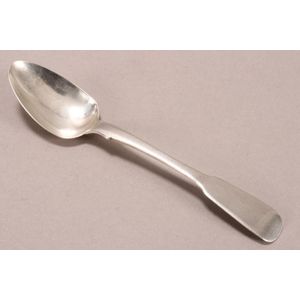Australian Colonial Silver Spoon by Robert Broad, Sydney, c.1835
Australian Colonial silver spoon by Robert Broad, Sydney, New South Wales, c.1835, marked RB with English style hallmarks, in fiddle pattern, total weight 20gm, length 14.5 cm Ref: see mark 2 in early Australian silver - the Houstone collection by J.M.Houstone (2012). Robert broad probably arrived in Sydney on board the sovereign on 21st February 1831. In July 1832 he advertised he had moved his business from George Street to King Street. He is listed in the Sydney Directories between 1833 and 1839 as a watchmaker, working jewellery and silversmith. The depression of 1840's drove him into liquidation. In 1842 his estate was sequestered. In 1844 he is listed as the proprietor of the town hall tavern on the corner of George and King Street.
You must be a subscriber, and be logged in to view price and dealer details.
Subscribe Now to view actual auction price for this item
When you subscribe, you have the option of setting the currency in which to display prices to $Au, $US, $NZ or Stg.
This item has been sold, and the description, image and price are for reference purposes only.
- Marrow Spoon - A spoon with a long handle and a narrow scoop shaped bowl, used to scoop and eat marrow from the hollow centre of roasted bones. Some marrow scoops are double ended with a different shaped bowl at each end.
- Hallmarks - A mark stamped on articles of precious metals in Britain, since the 14th century, certifying their purity. It derives its name from the Guild Hall of the Goldsmiths' Company, who recieved its Charter in 1327 giving it the power to assay (test the purity) and mark articles of gold and silver.
The hallmark will consist of several marks, including the:
- silver standard mark, indicating the purity of the metal. Sterling silver is .925 pure silver.
- the city mark indicating the city in which it was assayed eg London, Birmingham, York etc.
- the date mark, usually a letter of the alphabet in a particular font and case,
- a duty mark, indicating whether duty had been paid to the crown, and only in use from 1784 to 1890
The piece may include an additional mark, the maker's mark, although not forming part of the hallmark, will be located in the vicinity of the hallmarks.
Sometimes silver plated items will bear faux hallmarks, often confusing those not familiar with silver markings.
This item has been included into following indexes:
